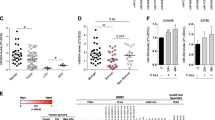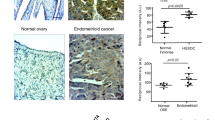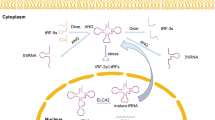Abstract
Polypyrimidine tract-binding protein (PTB) is an RNA-binding protein with multiple functions in the regulation of RNA processing and IRES-mediated translation. We report here overexpression of PTB in a majority of epithelial ovarian tumors revealed by immunoblotting and tissue microarray (TMA) staining. By western blotting, we found that PTB was overexpressed in 17 out of 19 ovarian tumor specimens compared to their matched-normal tissues. By TMA staining, we found PTB expression in 38 out of 44 ovarian cancer cases but only in two out of nine normal adjacent tissues. PTB is also overexpressed in SV40 large T-antigen immortalized ovarian epithelial cells compared to normal human ovarian epithelial cells. Using doxycycline-inducible small interfering RNA technology, we found that knockdown of PTB expression in the ovarian tumor cell line A2780 substantially impaired tumor cell proliferation, anchorage-independent growth and in vitro invasiveness. These results suggest that overexpression of PTB is an important component of the multistep process of tumorigenesis, and might be required for the development and maintenance of epithelial ovarian tumors. Moreover, because of its novel role in tumor cell growth and invasiveness, shown here for the first time, PTB may be a novel therapeutic target in the treatment of ovarian cancer.
This is a preview of subscription content, access via your institution
Access options
Subscribe to this journal
Receive 50 print issues and online access
$259.00 per year
only $5.18 per issue
Buy this article
- Purchase on Springer Link
- Instant access to full article PDF
Prices may be subject to local taxes which are calculated during checkout





Similar content being viewed by others
References
Bast Jr RC, Lilja H, Urban N, Rimm DL, Fritsche H, Gray J et al. (2005). Translational crossroads for biomarkers. Clin Cancer Res 11: 6103–6108.
Black DL . (2003). Mechanisms of alternative pre-messenger RNA splicing. Annu Rev Biochem 72: 291–336.
Bryan TM, Reddel RR . (1994). SV40-induced immortalization of human cells. Crit Rev Oncogene 5: 331–357.
Bushell M, Stoneley M, Kong YW, Hamilton TL, Spriggs KA, Dobbyn HC et al. (2006). Polypyrimidine tract binding protein regulates IRES-mediated gene expression during apoptosis. Mol Cell 23: 401–412.
Castelo-Branco P, Furger A, Wollerton M, Smith C, Moreira A, Proudfoot N . (2004). Polypyrimidine tract binding protein modulates efficiency of polyadenylation. Mol Cell Biol 24: 4174–4183.
Cornelis S, Tinton SA, Schepens B, Bruynooghe Y, Beyaert R . (2005). UNR translation can be driven by an IRES element that is negatively regulated by polypyrimidine tract binding protein. Nucleic Acids Res 33: 3095–3108.
Cote CA, Gautreau D, Denegre JM, Kress TL, Terry NA, Mowry KL . (1999). A Xenopus protein related to hnRNP I has a role in cytoplasmic RNA localization. Mol Cell 4: 431–437.
Faustino NA, Cooper TA . (2003). Pre-mRNA splicing and human disease. Genes Dev 17: 419–437.
Garcia-Blanco MA, Jamison SF, Sharp PA . (1989). Identification and purification of a 62 000-dalton protein that binds specifically to the polypyrimidine tract of introns. Genes Dev 3: 1874–1886.
He X, Ee PL, Coon JS, Beck WT . (2004). Alternative splicing of the multidrug resistance protein 1/ATP binding cassette transporter subfamily gene in ovarian cancer creates functional splice variants and is associated with increased expression of the splicing factors PTB and SRp20. Clin Cancer Res 10: 4652–4660.
Huang S, Deerinck TJ, Ellisman MH, Spector DL . (1997). The dynamic organization of the perinucleolar compartment in the cell nucleus. J Cell Biol 137: 965–974.
Jemal A, Murray T, Samuels A, Ghafoor A, Ward E, Thun MJ . (2003). Cancer statistics, 2003. CA Cancer J Clin 53: 5–26.
Jin W, Bruno IG, Xie TX, Sanger LJ, Cote GJ . (2003). Polypyrimidine tract-binding protein down-regulates fibroblast growth factor receptor 1 alpha-exon inclusion. Cancer Res 63: 6154–6157.
Jin W, McCutcheon IE, Fuller GN, Huang ES, Cote GJ . (2000). Fibroblast growth factor receptor-1 alpha-exon exclusion and polypyrimidine tract-binding protein in glioblastoma multiforme tumors. Cancer Res 60: 1221–1224.
Jin X, Burke W, Rothman K, Lin J . (2002). Resistance to p53-mediated growth suppression in human ovarian cancer cells retain endogenous wild-type p53. Anticancer Res 22: 659–664.
Kamath RV, Thor AD, Wang C, Edgerton SM, Slusarczyk A, Leary DJ et al. (2005). Perinucleolar compartment prevalence has an independent prognostic value for breast cancer. Cancer Res 65: 246–253.
Kasper JS, Kuwabara H, Arai T, Ali SH, DeCaprio JA . (2005). Simian virus 40 large T antigen's association with the CUL7 SCF complex contributes to cellular transformation. J Virol 79: 11685–11692.
Knoch KP, Bergert H, Borgonovo B, Saeger HD, Altkruger A, Verkade P et al. (2004). Polypyrimidine tract-binding protein promotes insulin secretory granule biogenesis. Nat Cell Biol 6: 207–214.
Kosinski PA, Laughlin J, Singh K, Covey LR . (2003). A complex containing polypyrimidine tract-binding protein is involved in regulating the stability of CD40 ligand (CD154) mRNA. J Immunol 170: 979–988.
Liu J, Yang G, Thompson-Lanza JA, Glassman A, Hayes K, Patterson A et al. (2004). A genetically defined model for human ovarian cancer. Cancer Res 64: 1655–1663.
Maines-Bandiera SL, Kruk PA, Auersperg N . (1992). Simian virus 40-transformed human ovarian surface epithelial cells escape normal growth controls but retain morphogenetic responses to extracellular matrix. Am J Obstet Gynecol 167: 729–735.
Matera AG, Frey MR, Margelot K, Wolin SL . (1995). A perinucleolar compartment contains several RNA polymerase III transcripts as well as the polypyrimidine tract-binding protein, hnRNP I. J Cell Biol 129: 1181–1193.
Mitchell SA, Brown EC, Coldwell MJ, Jackson RJ, Willis AE . (2001). Protein factor requirements of the Apaf-1 internal ribosome entry segment: roles of polypyrimidine tract binding protein and upstream of N-ras. Mol Cell Biol 21: 3364–3374.
Ozols RF, Bookman MA, Connolly DC, Daly MB, Godwin AK, Schilder RJ et al. (2004). Focus on epithelial ovarian cancer. Cancer Cell 5: 19–24.
Venables JP . (2004). Aberrant and alternative splicing in cancer. Cancer Res 64: 7647–7654.
Wagner EJ, Garcia-Blanco MA . (2001). Polypyrimidine tract binding protein antagonizes exon definition. Mol Cell Biol 21: 3281–3288.
Wang J, Pederson T . (1990). A 62 000 molecular weight spliceosome protein crosslinks to the intron polypyrimidine tract. Nucleic Acids Res 18: 5995–6001.
Wang Z, Lo HS, Yang H, Gere S, Hu Y, Buetow KH et al. (2003). Computational analysis and experimental validation of tumor-associated alternative RNA splicing in human cancer. Cancer Res 63: 655–657.
Wiznerowicz M, Trono D . (2003). Conditional suppression of cellular gene: lentivirus vector-mediated drug-inducible RNA interference. J Virol 77: 8957–8961.
Wollerton MC, Gooding C, Wagner EJ, Garcia-Blanco MA, Smith CW . (2004). Autoregulation of polypyrimidine tract binding protein by alternative splicing leading to nonsense-mediated decay. Mol Cell 13: 91–100.
Xu Q, Lee C . (2003). Discovery of novel splice forms and functional analysis of cancer-specific alternative splicing in human expressed sequences. Nucleic Acids Res 31: 5635–5643.
Zang WQ, Li B, Huang PY, Lai MM, Yen TS . (2001). Role of polypyrimidine tract binding protein in the function of the hepatitis B virus posttranscriptional regulatory element. J Virol 75: 10779–10786.
Acknowledgements
We thank Dr Didier Trono (University of Geneva, Switzerland) for his generous gift of lentiviral vectors LV-THM and LV-tTR/KRAB-Red as well as plasmids pMD2.g, pMDLg/pRRE and pRSV Rev. We are most grateful to our colleague, Martina Vaskova, for her outstanding administrative, technical, and intellectual assistance. We also thank Ahmet Dirim Arslan for technical assistance. Finally, we thank the GOG tumor bank for the EOC TMA. This work was supported by the GOG (a subcontract to WTB), the National Cancer Institute (WTB), and the University of Illinois at Chicago. It was conducted in a facility constructed with support from the NCRR NIH Grant C06RR15482.
Author information
Authors and Affiliations
Corresponding author
Additional information
Supplementary Information accompanies the paper on the Oncogene website (http://www.nature.com/onc).
Supplementary information
Rights and permissions
About this article
Cite this article
He, X., Pool, M., Darcy, K. et al. Knockdown of polypyrimidine tract-binding protein suppresses ovarian tumor cell growth and invasiveness in vitro. Oncogene 26, 4961–4968 (2007). https://doi.org/10.1038/sj.onc.1210307
Received:
Revised:
Accepted:
Published:
Issue Date:
DOI: https://doi.org/10.1038/sj.onc.1210307
Keywords
This article is cited by
-
MiR-297 inhibits tumour progression of liver cancer by targeting PTBP3
Cell Death & Disease (2023)
-
RNA-binding proteins in ovarian cancer: a novel avenue of their roles in diagnosis and treatment
Journal of Translational Medicine (2022)
-
A three-dimensional bioprinted model to evaluate the effect of stiffness on neuroblastoma cell cluster dynamics and behavior
Scientific Reports (2020)
-
PTBP1-mediated regulation of AXL mRNA stability plays a role in lung tumorigenesis
Scientific Reports (2019)
-
PTBP1 enhances miR-101-guided AGO2 targeting to MCL1 and promotes miR-101-induced apoptosis
Cell Death & Disease (2018)



